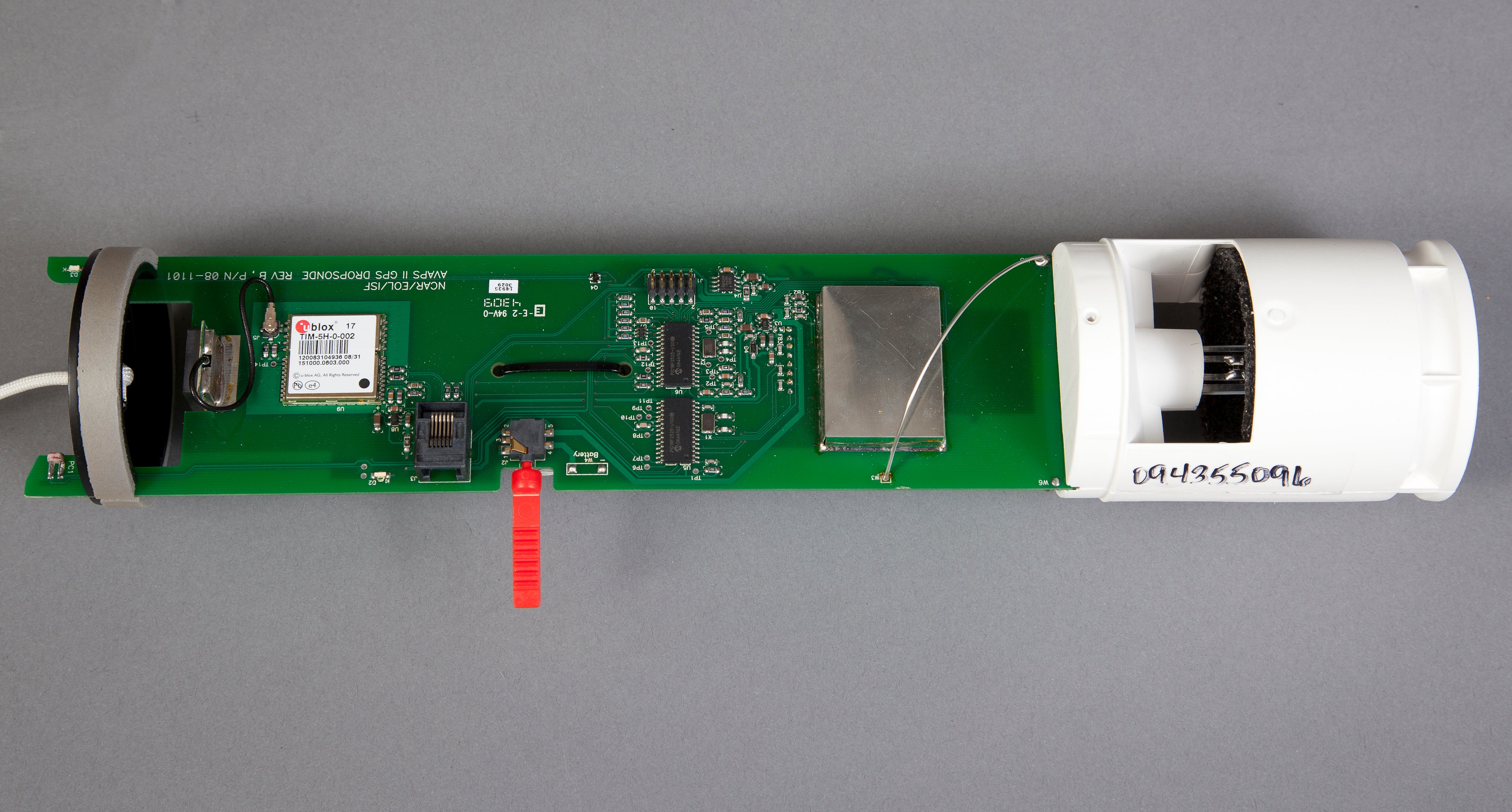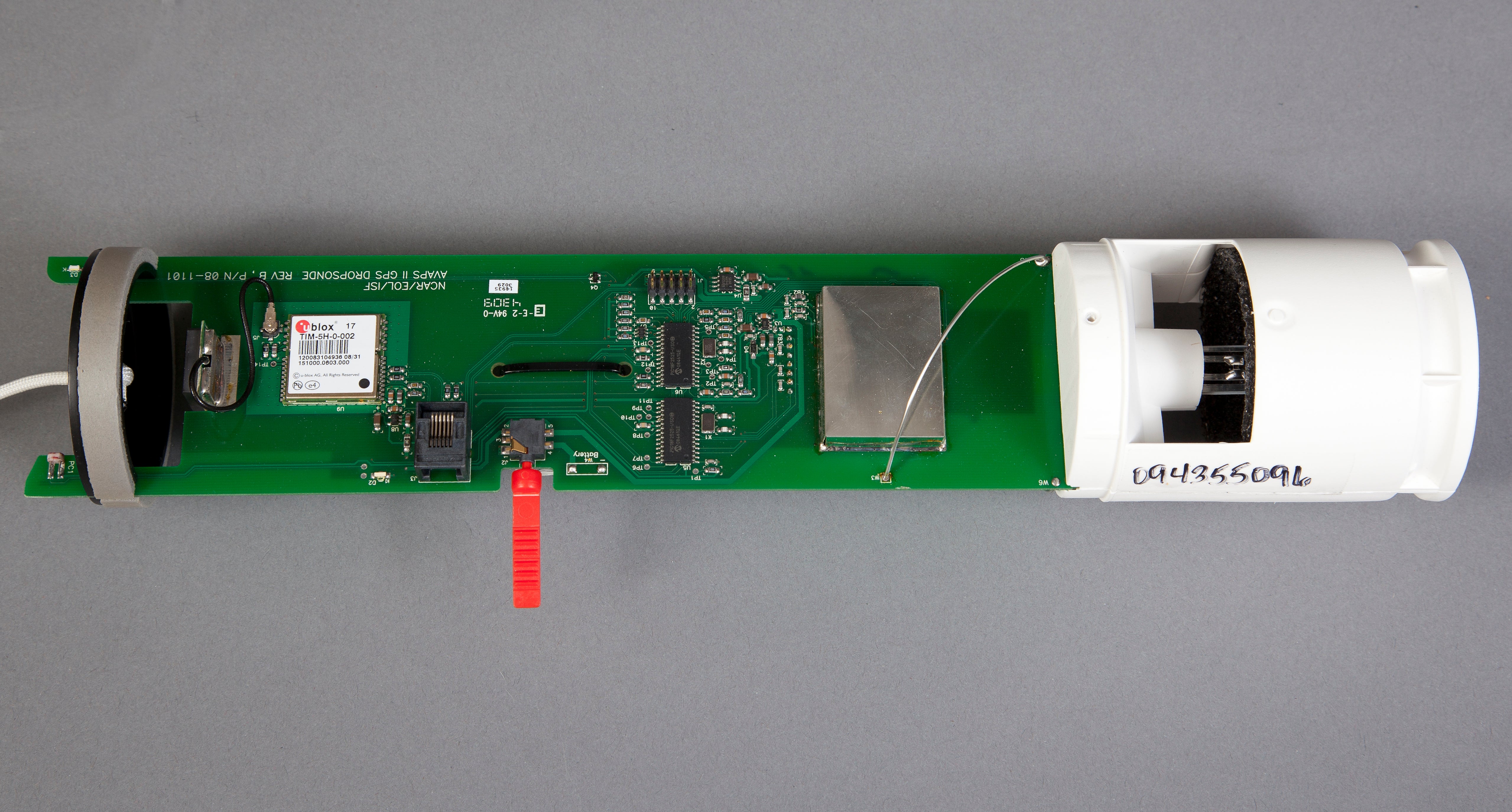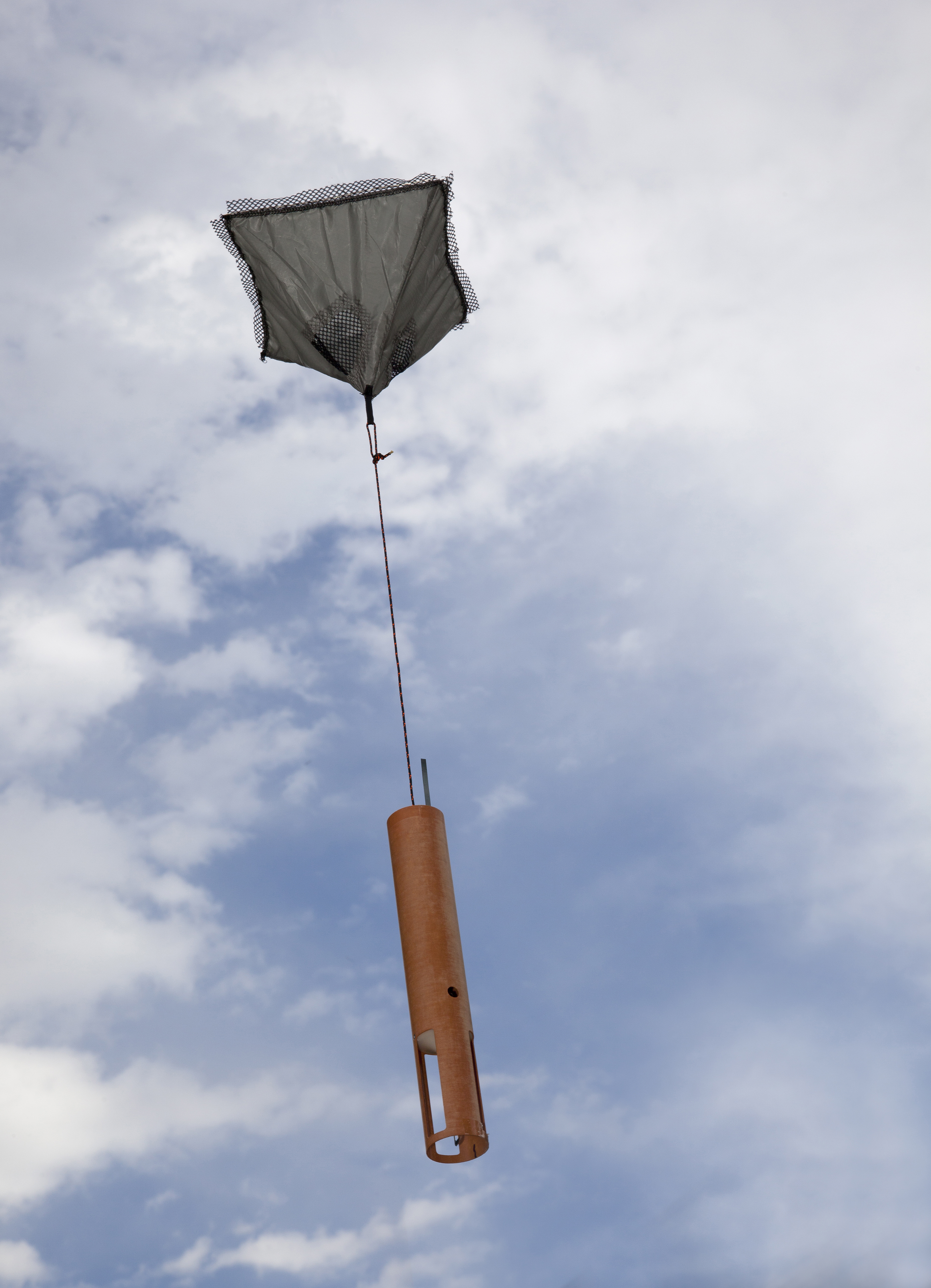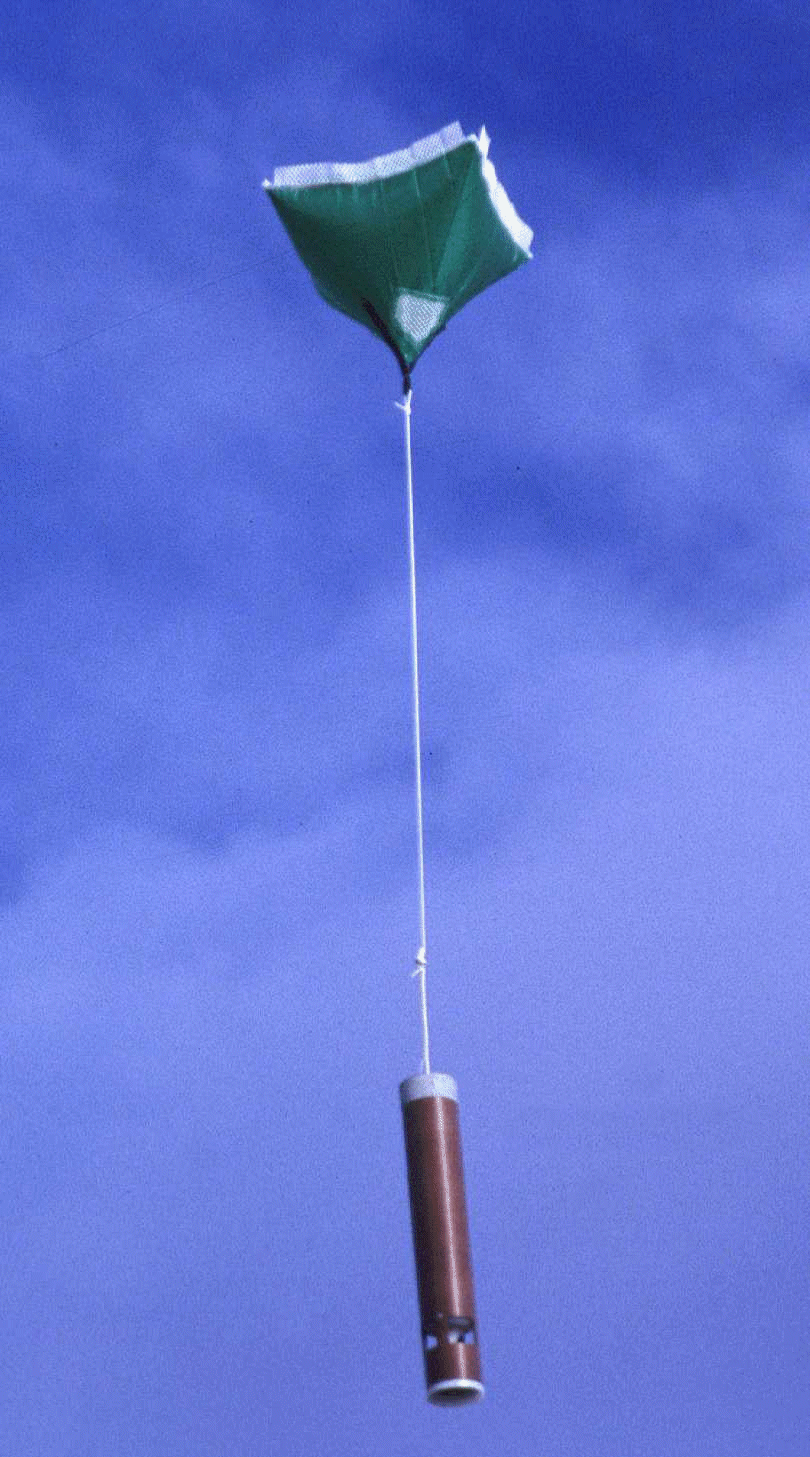Airborne Vertical Atmospheric Profiling System - Dropsondes
The Airborne Vertical Atmospheric Profiling System (AVAPS) is a requestable, aircraft mounted system that allows targetted observations with dropsondes, which are nothing more than aircraft ejectable variants of the typical balloon based radiosondes used heavily world wide. AVAPS, as a system, fully encompasses the entireity of:
- The dropsonde, or the ejected instrument
- The mechanical launcher
- The telemetry receiving subsystem
- Data recording software and computer
Dropsondes
Dropsondes are the core of AVAPS - the rest of the system is built around initializing, deploying, and recording data measured by the dropsondes. A Dropsonde (or sonde) is a small electronic device which contains atmopsheric sensors: pressure, temperature, humidity and a GPS receiver to dervie winds. The sonde is launched from an aircraft where a parachute is deployed. As the sonde descendes to the earth’s surface it continoulsy measures the state of the atmoshere and telemetries this information to the research aircraft. The aircraft is equiped with dedicated hardware and sofware to process the signal from the sonde in real-time to display and archive the data. Once the sonde has reached the sureface, all data collected during the descent can be sent via satellite to atmospheric research centers or the National Hurricane Center or the World Meterological Organization. The sonde in conjunction with the aircraft is the equivalent of a standard radiosonde or weather balloon launched by the National Weater Service launched twice a day from over 100 locations in the U.S
Atmospheric soundings from dropsondes provide the ability to measure conditions over remote areas such as the oceans, Polar Regions and land masses; they also provide a means to obtain soundings in and around severe weather systems, such as hurricanes. Atmospheric soundings obtained from sondes during hurricane reconnaissance flights have improved the accuracy of forecasts of hurricane landfall by about 20 percent over the decade of the 1990’s, with further improvements in the subsequent decades. In particular, the use of aircraft released sondes have had a dramatic impact on the forecast track of hurricanes.
The dropsonde incorporates a pressure, temperature, humidity sensor module (RSS903) designed by Vaisala, Inc., for their RS92 radiosonde and a GPS receiver module. The sensor specifications are shown in the following table.
Dropsonde Sensor Specifications
| Range | Accuracy | Resolution | |
| Pressure | 1080-100 hPa | ± 1.0 hPa | 0.1 hPa |
| Temperature | -90 to +60 C | ± 0.2 C | 0.1 C |
| Humidity | 0-100% | ± 5% | 1.0% |
| Horiz Wind | 0-200 m/s | ± 0.5 m/s | 0.1 m/s |
In addition to the RSS903 sensor module and the GPS receiver module, the dropsonde electronics board includes a microprocessor for measuring and controlling the sensor module and sending the measured data to the 100 milliwatt 400 MHz telemetry transmitter, and an 8-volt lithium battery pack for power. Surface mount technology is used on the electronics board to reduce size and increase the ease of manufacture. In addition, the electronics board contains a connector that serves as an RS-232 link with the aircraft data system for test and checkout and for setting the telemetry transmitter frequency prior to deployment. The transmitter can be set anywhere in the 400-406 MHz meteorological band in 20 kHz steps, creating about 300 separate channels.
A unique square-cone parachute is used to reduce the initial shock load and slow and stabilize the sonde. The parachute is immediately deployed on exit from the launch chute and streamers for about five seconds until filled by ram-air. The stability of the square cone parachute is very good during the sonde's descent and reduces or eliminates any pendulum motion of the sonde.
UCAR/Intellectual Property and NCAR/SSSF have licensed Vaisala Inc. of Woburn, Massachusetts to build the NCAR GPS Dropsonde, as Vaisala model RD93 and the subsequent RD94. Throughout the years, many dropsondes have be used (see a more detailed history), but in the recent past, only 4 variations of dropsondes have been produced in noteworthy quantities.
RD93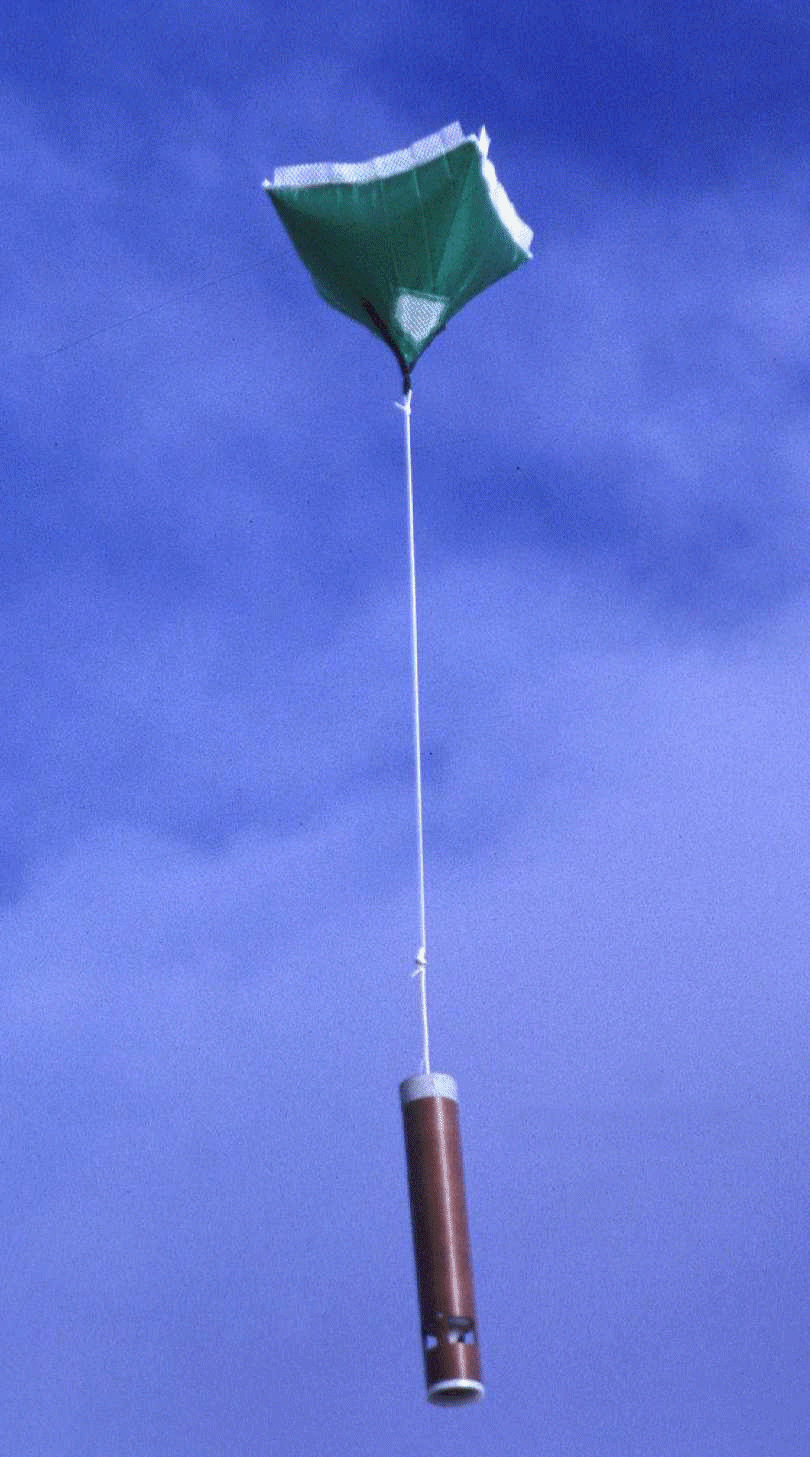
The RD93, though now obsolete, was for many years the mainstay AVAPS instrument. It was first designed in the late 90's and was used until ~2008. It was the first dropsonde to use GPS signals for wind finding. The RD94, the successor to the RD93, has the same dimensional size, but if slightly lighter.
RD94
The RD94 is the currently produced dropsonde. It is the same physical size as the RD-93, but with upgraded electronics,slightly lighter weight, and incorporates a different data transmission scheme. It can only be used in manual launchers
MIST
The Miniture Insitiu Sounding Technology (MIST) sonde is exclusively used for driftsonde. It is shown here because it was the first sonde in the 1.75"x12" form factor.
Mini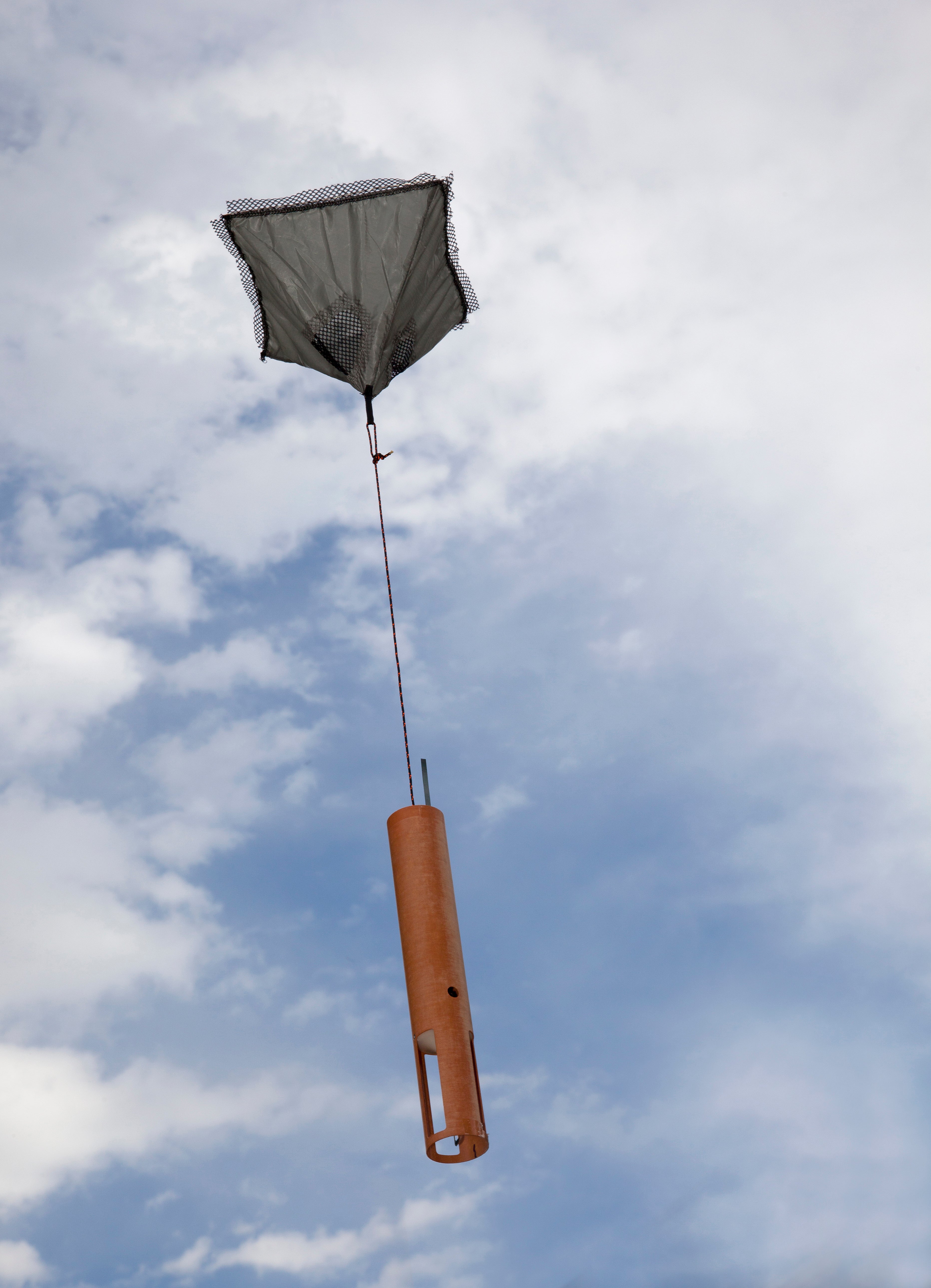
The Mini sonde is electrically equivalent to the RD-94 dropsonde. The chief difference is that is has been designed to work in automated environments.
| Dropsonde | Diameter (in [cm]) | Length (in [cm]) | Weight (oz [g]) | Launcher Type | Availibility | Comments |
|---|---|---|---|---|---|---|
| RD93 | 2.75 [6.99] | 16.0 [40.6] | 14.1 [400] | Manual | Obsolete | Last Produced in 2009 |
| MIST | 1.75 [4.45] | 12.0 [30.48] | 6.5 [184] | Gondola Only | - | Produced for Driftsonde |
| RD94 | 2.75 [6.99] | 16.0 [40.6] | 11.3 [320] | Manual | Commercially | Production started in 2008 |
| Mini | 1.75 [4.45] | 12.0 [30.48] | 5.9 [167] | Manual / Automated | NCAR | NCAR working towards commercial viability |
Launchers
Generally speaking, AVAPS Launchers fall in a range of "automated", but for the sake of clarity, they typically are either manually operated, or automatically controlled. As would be expected, the automated launchers are much more complex, but the gains are a much simpler interaction with AVAPS. Manual systems are still used by the bulk of AVAPS community, but there is growing interest in automated systems.
Manual Launchers
Automated Launchers
Currently, there are only 2 fully automated AVAPS Launchers. One is implemented on the NSF/NCAR G-V and the other is on the NASA Global Hawk.
Receiver Telemetry Subsystem
Each install of AVAPS requires a receiver telemetry system. The receiver telemetry system comprises some sensitive 400MHz radio frequency (RF) modules with some tunable decoding hardware. All these components are integrated into a 3U (5.25") tall 19" rack that mounts into standard width computer racks. The chassis is constructed of the following electrically identical removeable modules:
- One Power Supply Module: A single Power Supply module provides the DC voltage required for telemetry chassis operation.
- Telemetry Receiver Module: The Telemetry Receiver module is a narrow-band 400 MHz receiver used to receive and demodulate the telemetry data from the dropsonde. Depending on requirements, there can be up to 10 receivers in a chassis, where 8 can track sondes, one records engineering data for all of the deployed dropsondes, and the last is a potential spare.
- Dropsonde Interface Module: The dropsonde interface module provides the local interface required to prepare a dropsonde for launch. The dropsonde is connected to the module using an RS-232 cable. Through this interface, RD94's can be initialized from dropping.
Data Recording Software (THIS BADLY NEEDS TO BE CLEANED UP)
The aircraft data system is completely different, both in system software and hardware, from all previous dropsonde systems NCAR has developed. The most significant development in the hardware is the narrow-band 400 MHz telemetry receiver. The design requirements of the aircraft data system are:
Operation by one person
Receive and process data from four dropsondes simultaneously
Simple Graphical User Interface (GUI)
Continuously output real-time PTH and wind for each channel to the aircraft computer systems as the dropsondes are descending
Operation on aircraft with or without aircraft data systems.
The most significant feature of the AVAPS data system is its ability to receive and process data from up to 4 sondes simultaneously, essential for obtaining a fine horizontal distribution of soundings. Launch procedures are simple enough to allow releases less than 20 seconds apart, if desired.
The aircraft hardware is typically composed of a Personal Computer (PC) with a Pentium processor, color monitor, telemetry chassis, and printer. The hardware is designed for installation into a standard 19-inch rack. The system also requires a GPS antenna mounted on the top of the aircraft and a UHF antenna, for receiving the dropsonde signal, mounted on the bottom of the aircraft. If available, an RS-232 connection to the main aircraft data system for flight level information is highly desirable.
The AVAPS system software is written in LabVIEW, a graphic programming language developed by National Instruments that permits multi-tasking in the Windows 95 operating system. Multitasking capability is critical for a multi-channel dropsonde data system. The system software performs several functions prior to release of a dropwindsonde. The software logs the current system configuration and flight mission information, and initializes all electronic hardware for the release. A graphical spectral analysis of the 400-406 MHz meteorological RF band is provided so that the operator can select a transmitter frequency free of interfering signals. The system then performs a functional test of the sonde's PTH sensors and the 400 MHz transmitter by displaying cabin PTH measurements from the sonde transmitted through the 400 MHz telemetry link. When configured, the PC also communicates with the aircraft's sonde launch system, via the Dropsonde Telemetry Chassis, to launch a sonde at the operator's command. If the host aircraft has a data system to provide flight-level meteorological data (pressure, air temperature, dew point, wind speed, wind direction, altitude, etc.), these are automatically received by the AVAPS PC. However, the AVAPS does not require an interface with a flight-level data system in order to function.
After launch, the software processes PTH and GPS data from up to four dropsondes via the Dropsonde Telemetry Chassis and 16-port I/O panel. Both PTH and wind data are available every 0.5 s, although because they are obtained from independent modules, the PTH and wind measurements are not made at precisely the same times. The AVAPS system PC pairs the PTH and wind data that are most closely matched in time, and then displays, in real-time, selected parameters to the color monitor, including pressure, temperature, relative humidity, wind speed and direction, number of GPS satellites being tracked by the dropsonde, and geopotential altitude (computed hydrostatically from the PTH data). These and other parameters are also stored on the PC hard drive for archiving, and can be directed to other computers on the aircraft for further processing and transmission off the aircraft.
After a sounding is complete, the data can be analyzed and modified using a separate program, ASPEN (Atmospheric Sounding Processing Environment). ASPEN has the following capabilities:
Automatically apply quality control procedures to the sounding data
Present data in tabular and graphical forms
Automatically determine levels and code them in WMO message formats
Transmit the WMO messages to other systems
Save the raw and derived data products in various formats
Since Aspen can process data provided in the AVAPS "D" file, NCAR GLASS and NCAR CLASS formats, it is able to analyze both dropsonde and upsonde soundings. Aspen is designed to operate as automatically as possible, while allowing the user to have some control over the QC methods. For instance, as soon as the user selects a sounding file for processing, the data is brought into Aspen and automatically analyzed. In most cases this first pass will be the only one required. If the processing needs to be modified, the user can change the QC parameters and reprocess the data as many times as necessary. An extensive series of QC algorithms are applied to the data. These algorithms typically have one or two parameters that may be adjusted by the user if the default values are not suitable for a particular sounding. The user can save the modified options, so that when a new sounding is opened, the initial analysis will use the customized QC parameters. Aspen can have up to six sounding files open at the same time. This makes it convenient to compare soundings
AVAPS vs AVAPS II
AVAPS as an instrument is nearing a 2 decades in existance, and has undergone a few important changes due to obsolence of key components and general improvements in the electronics industry. The most recent is the move towards a new dropsonde and telemetry system, which was developed in conjunction with NOAA, the USAF, and the wider user community in the 2008-2009 timeframe. Duing this period, it was expediant to have designations for both systems as the new changes from AVAPS to AVAPS II are not backwards compatible (eg, you cannot use an old AVAPS dropsonde with the new telemetry receiver). References to "AVAPS II", are a holdover from this conversion timeframe of 2008-2010. Any current system will use "AVAPS II" subcomponents.
Research Aircraft Configurations
NCAR has been involved directly with installing AVAPS onto the following aircraft platforms
| Institution | Years | Sonde | Operational Availibility |
|---|---|---|---|
| NCAR / NSF C-130 | 90's | RD93 | Viable, but for RD94 |
| NCAR / NSF Gulfstream V | 2005 | RD93 | Viable, but for RD94 |
| NASA DC-8 | 1990 | RD93 | Viable, but for RD94 |
| NASA ER-2 | 2001 | RD93 variant | Obsolete |
| NASA Global Hawk | 2010 | Mini | Operational |
| NCAR / NSF Gulfstream V | 2013 | Mini | Operational |
Additional AVAPS Users
NCAR is not the exclusive user of AVAPS. AVAPS is more routinely used by other organizations such as NOAA Aircraft Operations Center and the US Air Force Hurricane Hunters.
| Group | Country of Origin | Website | Comments |
|---|---|---|---|
| NOAA AOC | USA | SSSF has built a "double" 8-channel AVAPS system plus spares for the NOAA G-IV and two additional data systems plus spares for the two NOAA P-3's. These systems were delivered to NOAA in August 1996 for testing and use, and have since been used in numerous research programs as well as operational forecasting of tropical and winter storms. | |
| USAF 403rd and 53rd | USA | ISF has also built 10 AVAPS systems plus spares for the 53rd Weather Reconnaissance Squadron (aka Hurricane Hunters) at Keesler Air Force Base in Biloxi, Mississippi. These systems are operational in their WC-130J aircraft. During a typical hurricane season, the 53rd deploys 1000 to 1500 sondes on training and storm missions. | |
| DLR | Germany | An AVAPS system has also been built for DLR in their Falcon research aircraft. | |
| AES | Canada | SSSF has also built and installed an AVAPS system in Atmospheric Environmental Services (AES) Canada-s Convair 580 research aircraft | |
| Met Office | UK | UCAR/Intellectual property and EOL/SSSF has also licensed Vaisala to sell the AVAPS system to their customers worldwide. One such system has been installed in the United Kingdom Meteorological Office's BAE-146, operated by the Meteorological Research Flight (MRF) division. | |
| NIPR | Japan | Vaisala has sold another system to the National Institute for Polar Research (NIPR) in Japan. | |
| NCAR | USA | NCAR has one AVAPS system, which can be used in NCAR's C-130 or G-V, or by the scientific research community in other aircraft, such as the NASA DC-8. |
